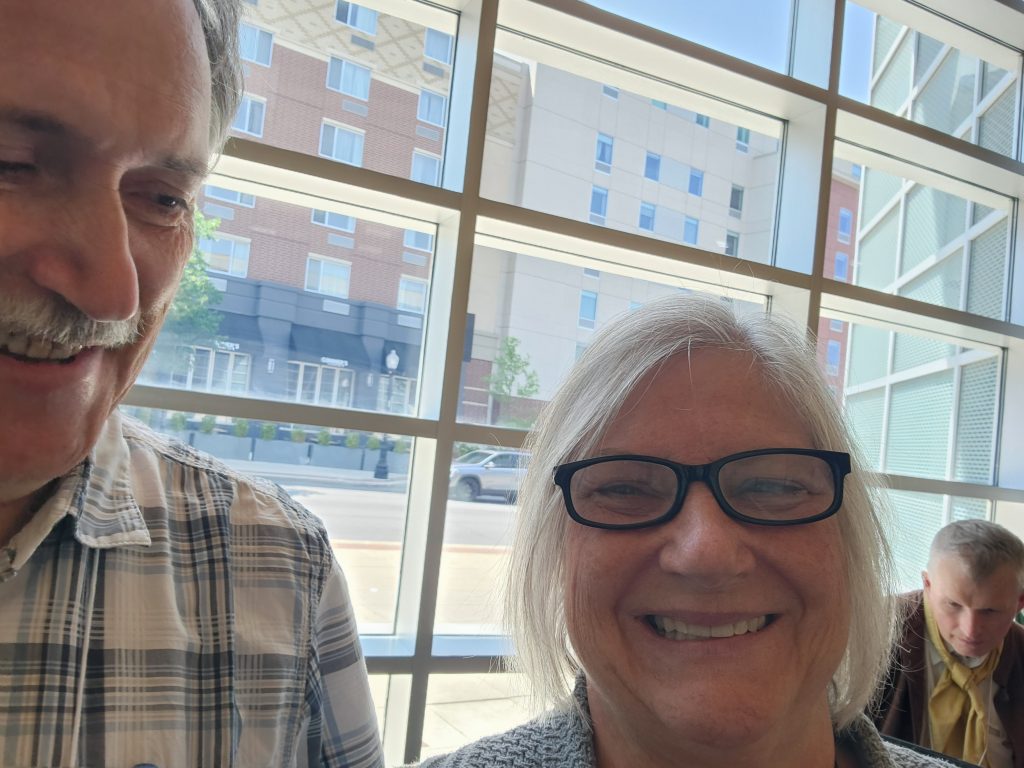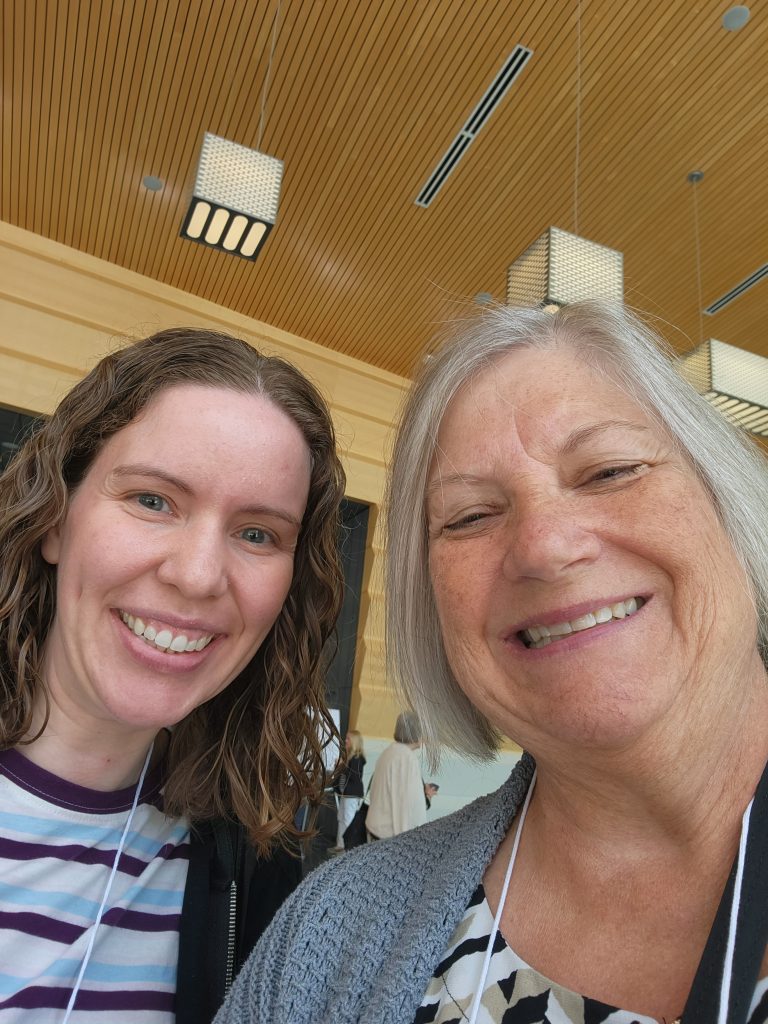
It’s definitely a small world and I have to blog about my newfound cousin, Gerhard. I didn’t even realize that the man in the background in the photo, Roland, was in this shot until I uploaded seconds ago. He’s a part of this story, too. Warning you, this is one of my weird genealogy encounters. . .
Last December I was applying to the Society of Indiana Pioneers (SIP) and needed a German translation of a newspaper record I found for my Leininger family. Husband was stumped by the script used and some of the words; the translation wasn’t making sense and online translation programs weren’t helping, either. I posted a request for help on a Facebook page and the Transitional Genealogy Forum (TGF). Roland responded and saved the day. A few weeks later, I was accepted into the SIP and Roland posted about the upcoming International German Genealogy Partnership (IGGP) that was to be held in Ft. Wayne June 9-11.
I have German ethnicity on my paternal side and have never attended a conference specifically for ethnicity. Since I now live in the greater Ft. Wayne area, I was saving time and money on travel, hotel, and meals. I decided the price, date, and location were perfect for me so I signed up with no expectations.
The conference used the WHOVA app which I used for the Association of Professional Genealogists (APG) conference last year. I wasn’t too active on the app last year as I was in the process of moving and had limited time. I highly recommend using whatever social media is available pre and during a conference to get the most out of the experience. Go back after the conference and save links/chats from the app as it is usually only available for a limited time period.
I set up pre-meetings virtually (the conference was hybrid) based on family surnames – Leininger, Kettering, Kable, and Kuhn. Gerhard recognized the surname Kuhn and messaged me that he had information he wanted to share with me in person. We agreed to meet between conference presentations. The message arrived a few minutes after I left Kessler Cemetery where I had just cleaned graves for these ancestors. Weird, I thought.
We met up on Saturday and he brought with him a transcription of military records and a copy of my 4th great-grandparent’s marriage registration. The 4gg’s were the immigrants and are buried in Kessler. I’m a member of the Daughters of Union Vets of the Civil War based on one of their son, Henry’s, service. For my long-time readers, Henry married Maria Duer, daughter of John who is buried in Kessler with no surviving marker.
Gerhard looked up from the table we were at and recognized one of my cousins, who I had never met, passing by. He called her over:

We had messaged each other on the app earlier but her immigrants settled in a different part of Ohio and we weren’t sure we were related. Gerhard knew that we were and explained how. I brought up my family tree and she recognized another line we share, the Anstatts.
Gerhard also informed me that another one of my German families that I hadn’t even thought to include in my surname post was having a 200-year immigration reunion in Brazil next summer. Evidently, my Bollenbacher ancestors left Germany, my line settled in Ohio and a brother went to South America. Who knew? Gerhard, thankfully!
This brings me to point out the value of doing surname studies and/or chasing all of your lines’ immigration routes, including their siblings. I have done that with many of my Great Britain families and my Croatian lines but not my French/German. That’s now on my to-do list.
Excluding my three first cousins, I have never met anyone related to most of my French-German lines. Although Gerhard and Renee are not close genetically, we do share a common 4-5th great-grandparent.
I have connected with relatives through DNA matches, online family trees, and the Roots Tech app but I never met with anyone face-to-face at a conference. It is an extra special occasion. My husband and I are now planning a trip next year to tour the region my ancestors and his came from on our way to Sweden to follow in his family’s footsteps. BTW, my husband’s Harbaughs are from a village close to where my Leininger family originated – probably even knew each other back in the 1600s. Yep, small world!
As if that wasn’t enough, here’s another reason to attend an ethnic-oriented genealogy conference – I found information on my British and Croatian lines, too. My Daniel Hollingshead purportedly served in the British military and fought in the Battle of Blenheim where one of his brothers was killed. No info anywhere in Great Britain because neither brother was an officer. I asked for help and was given several sources in Germany to research. Hoping I find a Hollingshead buried there.
I had no expectations I would find any information on my Croatia relatives at a German conference. It didn’t dawn on me that dear old Napolean would have made that connection. Croatia was once part of Austria-Hungary and we all know what Napolean did to that area and what is now Germany. My biggest mystery after researching in Croatia remained to find my great grandfather Josip Kos’ military records. Croatia says they were sent to Vienna; the Austrian State Archives says they are all on FamilySearch. I can’t find them there and haven’t gotten an answer from FamilySearch on where they reside or if they are ever going to be available online. A researcher who attended the conference and is familiar with the records is checking for me in Vienna. Hopefully, I will one day discover the truth behind the family story of why Josip separated from the Calvary.
By attending IGGP and using the Whova app, I was able to get hints for further research on all of my ethnic origins and meet relatives I didn’t know existed. The reasonable fee to attend was priceless!
IGGP has a conference every two years and I plan to attend in Columbus, Ohio in 2015. Perhaps you’ll join me. At the last conference, Hank Z. Jones was honored and I’ve blogged about his books previously. Yes, this was definitely a Psychic Roots encounter.

